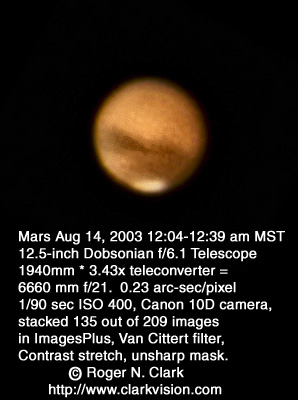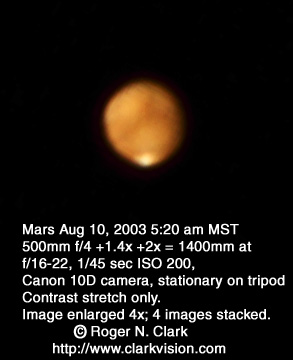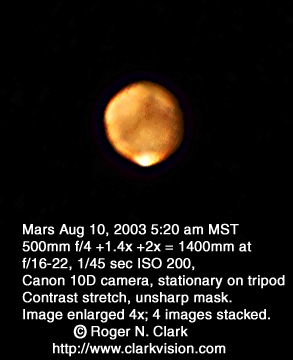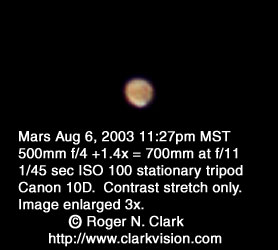
Mars 2003
Mars in August, 2003 will be closer to Earth than in recorded history. I thought I would try something different: photograph Mars with standard photographic equipment: a telephoto lens and a tripod, with a digital camera. Here are some results.

Mars with a telescope and no clock drive. The central longitude is near 180 degrees, with Elysium and Amazonis compresing the bright orange area above center in this north is up image. The dark area is Cimmerium region. The south polar cap is at the bottom. Elysium is a volcanic region mantled by dust. The dark areas are exposed basaltic rocks.
Seeing was generally poor, about 2 arc-seconds blur. The ImagesPlus software was used to automatically find Mars within the 6-megapixel frame, and autoalign the images. I then graded the quality and selected A and B (17 images) and added them. Filtering showed too much noise, so I then selected 135 A + B + C quality images and had to do a lot of filtering and contrast stretch. Before the filtering, I separated the red, green and blue channels into separate images and auto-aligned them in ImagesPlus. I then combined them back to an RGB color image. Finally I converted to 8-bit in photoshop, converted to LAB more and contrast stretched the luminance channel. Then back to RGB and contrast stretched the red, green and blue channels separately. I then unsharp masked the central portion. I selected just inside the planet edge, feathered the edge and then did the unsharp mask. This avoids the edge brightening you see on many filtered planet images.


Mars with a telephoto lens. Mars, August 10, 2003. North is up. You can clearly see the south polar cap (bright spot at the bottom). Just above the polar cap is light (reddish) spot called Hellas, a giant impact basin. Above that is a dark area extending almost to the northern limb; this is the shield volcano Syrtis Major. The evening terminator is on the right side of the image, and clouds over the morning limb are seen as bright areas at the upper right edge. Just to the left of Syrtis Major is Arabia: a cratered region with lots of dust. The reddish color is caused by the iron oxide mineral hematite, and the dark areas are exposed volcanic basalts.
The image was obtained with a Canon 500 mm f/4 IS L lens with a 1.4x teleconverter followed by a 2x teleconverter then the camera. White balance was set to "sun." The above Mars image is 4 frames stacked in photoshop. First, each frame was enlarged 4x. The 4 frames were all obtained at ISO 200, 1/30 sec at f/16, 1/45 sec at f/16, 1/45 sec at f/22, and 1/45 sec at f/22 using mirror lockup. The images were stacked to reduce noise as I underexposed a little. The images showed red and blue fringing due to differential refraction. I shifted the red and blue channels to align them with the green channel. I only did contrast stretching (no filtering of any kind) for one image, and then added unsharp masking for the second version. Contrast stretching was done in LAB mode on the luminance channel and in RGB mode on individual red, green and blue channels. Compare the detail with stacked teleconverters to the 1.4x TC only image below. Images with no teleconverter on the 500 mm lens would barely show the polar cap. These images show that interesting images of Mars can be obtained with as little as about 1000 mm focal length. Plate scale in the above image was about 1.1 arc-second/pixel (the Canon 10D has a pixel spacing of 7.4 microns), thus the 4x enlarged image has a plate scale of about 0.27 arc-seconds/pixel. Seeing (atmospheric turbulence) limits the detail in the image to worse than an arc-second. A 1400mm focal length lens at f/16 has an aperture of 3.4 inches, and at f/22 only 2.5 inches, thus the average aperture is only 3.0 inches. The diffraction spot size of a 3.0-inch telescope is 3.6 arc-seconds (diameter of first minimum in green light). Thus, the above image is essentially at the diffraction limit. The polar cap, for example appears about 2 arc-seconds across.
Note: the rotation of the Earth could cause smear if your exposure times are less than about 1/30 second. Mars is moving at a rate (due to earth's rotation) in the sky of about 14 arc-seconds per second, and mars is a maximum 25.1 arc-seconds across this month (August 2003).

This image of Mars was taken with a photographic outfit, not a telescope. The image shows the martian south polar cap (bright spot at the bottom), clouds near the limb of the planet, and dark markings in the center. It shows that you do not need a big telescope to see something on Mars. You do need a good telescope to see and record a lot of detail, however. The plate scale on the camera sensor was 2.1 arc-seconds per pixel.